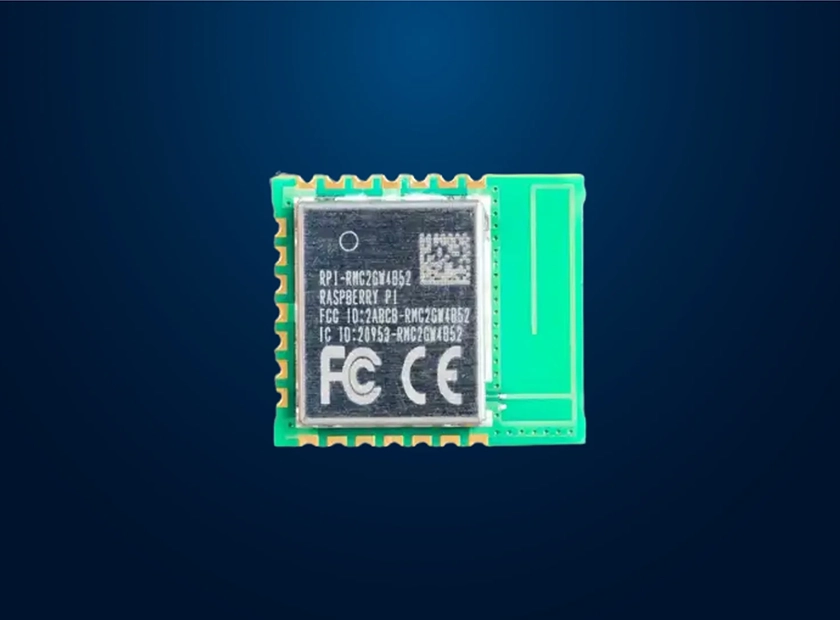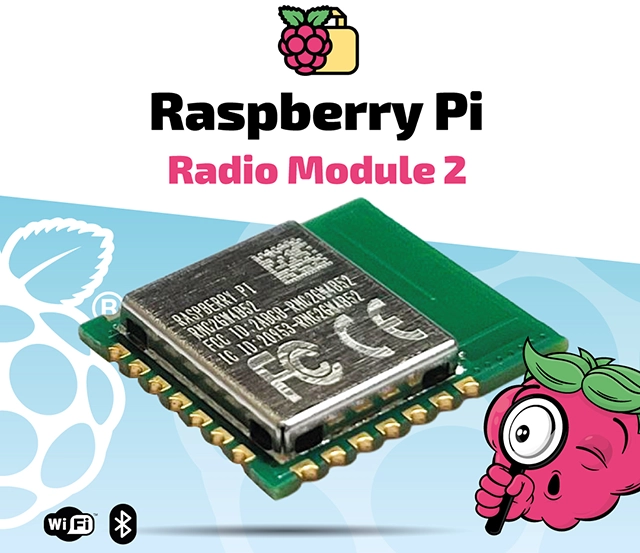How to Choose Between the Raspberry Pi Radio Module 2 and the Pico W

What is the Radio Module 2?
The new Radio Module 2 (RM2) from Raspberry Pi is a highly integrated, standalone radio module designed specifically for Raspberry Pi microcontrollers like the RP2040 and RP2350. At its core is the Infineon CYW43439 wireless chip, providing stable 2.4GHz Wi-Fi 4 (802.11n) and Bluetooth 5.2 (with support for Classic and Bluetooth Low Energy).
The module features a compact 14.5mm × 16.5mm form factor and a castellated package, designed for Surface-Mount Technology (SMT) processes, making it easy to integrate onto custom Printed Circuit Boards (PCBs). It integrates the RF circuitry, a 37.4MHz crystal, an onboard antenna, and an RF shield, requiring only minimal external components (SPI, power, and reset signals) to function. With its low official Recommended Retail Price (RRP), it's designed to provide a cost-effective wireless solution for mass-produced devices.
Introducing New Raspberry Radio Module 2
How Does It Differ from the Pico W?
To understand the value of the Radio Module 2, it's crucial to clarify its relationship with the Pico W development board. They aren't replacements for each other, but rather partners that serve different stages of the product development lifecycle.
The table below provides a clear, at-a-glance comparison:
| Feature Comparison | Raspberry Pi Pico W | Raspberry Pi Radio Module 2 |
|---|---|---|
| Product Role | Complete Development Board | Core Wireless Component/Module |
| Target Use Case | Learning, development, prototyping | Integration into custom PCBs for mass production |
| Included Components | RP2040 MCU, wireless chip, USB, power circuits, etc. | Only the wireless chip, antenna, and support circuitry |
| Method of Use | Connects directly to a PC via USB for programming | Soldered onto a host PCB via SMT |
| Core Wireless Solution | Infineon CYW43439 | Identical (Infineon CYW43439) |
| Software Compatibility | Uses Pico SDK (C++/MicroPython) | 100% Compatible with Pico SDK |
A Seamless Transition from Prototype to Production
As the table shows, while they differ in form and function, they share a unified core technology. The Radio Module 2 uses the exact same wireless chip and software architecture as the Pico W and Raspberry Pi Pico 2.
This means:
- Software Reusability: Wireless code written and validated on a Pico W using the C/C++ SDK or MicroPython can be used directly on a final product incorporating the RM2, typically with no modifications.
- Development Workflow Continuity: Developers can rapidly validate their concepts on a Pico W. Once the design is finalized, they can use the RM2 on their custom hardware for mass production. This workflow avoids the significant effort of re-engineering firmware for a different hardware platform, ensuring project continuity and reliability.
Raspberry Pi Radio Module Overview
Why Should You Choose It?
The features of the Radio Module 2 offer significant support for developers and businesses turning ideas into real products. To better illustrate its value, let's look at a few hypothetical use cases:
Use Case 1: The Smart Home Startup
A small startup plans to launch a "smart plant monitor" with a minimalist design that needs to be embedded compactly into the rim of a flowerpot.
- The Challenge: The standard rectangular form factor of the Pico W is too large and doesn't fit the product's aesthetic or spatial constraints. They need a custom circular PCB.
- How the RM2 Solves It: The team uses the Radio Module 2. This gives them the freedom to design their own circular mainboard, easily placing the tiny RM2 module on it. Because the software is fully compatible with their Pico W prototype, they essentially "copy-paste" their code to complete the product's firmware. The result is an elegantly designed product launched with a lower Bill of Materials (BOM) cost and a faster development cycle.
Use Case 2: The Industrial IoT Solution
A systems integrator has a project to deploy hundreds of asset trackers in a warehouse under a very tight budget.
- The Challenge: Using a Pico W for each tracker would exceed the budget. More importantly, subjecting hundreds of devices to individual radio certification is a complex and prohibitively expensive process.
- How the RM2 Solves It: They opt for a solution using an RP2040 chip paired with the Radio Module 2. The RM2's pre-certified modular approval is a key advantage, saving them tens of thousands of dollars in certification fees and months of waiting. At the same time, the module's low unit price helps keep the total cost of mass deployment under control.
Use Case 3: The Custom Electronic Art Project
An artist is creating an interactive light installation composed of multiple translucent spheres with limited internal space.
- The Challenge: She needs to place a controller inside each sphere to receive commands and drive LEDs, but she is not an RF engineer and designing her own antenna and radio circuitry is high-risk.
- How the RM2 Solves It: The Radio Module 2 provides her with a "black box" solution. She doesn't need to worry about any complex RF engineering. She simply reserves space for the RM2 on her small custom control board. This allows her to focus all her energy on the creative implementation of the light art and its software, significantly lowering the project's technical barriers and risk of failure.
These use cases highlight the core value of the Radio Module 2: accelerating time-to-market and reducing total cost.
- Accelerated Time-to-Market: The RM2 comes with modular wireless certification for key markets like the USA (FCC) and the EU (CE). This means developers don't need to conduct full, costly, independent certification for the wireless part of their product, saving time and money to get to market faster.
- Controlled Production Costs: Its low price point, combined with minimal external component requirements, can significantly lower the Bill of Materials (BOM) cost. Its SMT-friendly package is also cost-effective for automated mass production.
- Reduced Development Risk and Effort: Software compatibility with the Pico W means developers can reuse validated code and development experience, avoiding time-consuming low-level driver debugging and migration, and allowing the team to focus more on core product features.
Frequently Asked Questions (Q&A)
Q: What is the difference between a Raspberry Pi and a Compute Module?
A: This question is a great analogy for the relationship between the Pico W and the Radio Module 2. A standard Raspberry Pi (like a Pi 4 Model B) is a full-featured, ready-to-use single-board computer. A Compute Module (CM), on the other hand, takes the core functionality (processor, memory) and puts it on a small board designed for industrial and embedded applications, which requires a carrier board to function. Similarly, the Pico W is a complete development board, while the Radio Module 2 plays a role like a "Compute Module": it packages the wireless functionality as a core component, allowing you to integrate it into any custom product.
Q: What can you do with a Raspberry Pi Compute Module?
A: A Compute Module is primarily used in highly customized commercial and industrial products, such as digital signage, thin clients, and industrial automation equipment. Likewise, the use cases for the Radio Module 2 are focused on final products, for example:
- Smart Home Devices: Designing smart plugs or environmental sensors of any shape.
- Industrial IoT: Manufacturing low-cost, mass-deployable wireless data acquisition terminals.
- Custom Consumer Electronics: Creating uniquely shaped remote controls, wearables, or interactive art installations.
Q: What is the best Raspberry Pi?
A: There is no single "best" Raspberry Pi, only the "best fit for your current task." This principle applies perfectly to the Pico family as well:
- If you are in the learning, experimenting, or prototyping phase, the Pico W is the appropriate choice because it's ready-to-use and extremely convenient.
- If your project has been validated and you're preparing for mass production with specific requirements for cost, size, or form factor, then designing a custom board with an RP2040 chip and the Radio Module 2 is the superior solution.
Q: Does CM4 have WiFi?
A: Yes, some variants of the Compute Module 4 integrate Wi-Fi and Bluetooth. In a similar vein, the Radio Module 2 discussed here also provides comprehensive wireless connectivity. Specifically, it supports Wi-Fi 4 (802.11n, 2.4GHz) and Bluetooth 5.2 (Classic + LE). This is sufficient for the vast majority of IoT and embedded projects and strikes a good balance between cost and power consumption.
As the Q&A section highlights, the factors developers consider when choosing a wireless solution go far beyond mere technical specifications; they are also concerned with the practical development experience, time-to-market, and final overall cost. This is precisely the perspective from which the Radio Module 2 was designed. It isn't simply the Pico W's wireless functionality repackaged into a module; rather, it's a clear, low-risk pathway that Raspberry Pi has established for its ecosystem to bridge the gap between prototyping and commercial mass production. It systematically addresses the common challenges of certification, cost, and engineering complexity that developers face in this transition. Therefore, when your project is ready to move from the workbench to the market, choosing the Radio Module 2 provides a more efficient route—one that allows you to focus your valuable resources on product innovation itself, rather than on complex RF engineering and certification processes. This embodies the core principle of the Raspberry Pi ecosystem: empowering developers by lowering barriers.


